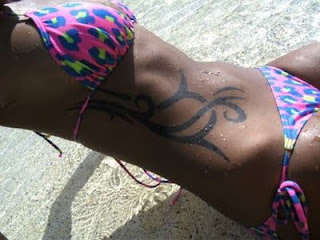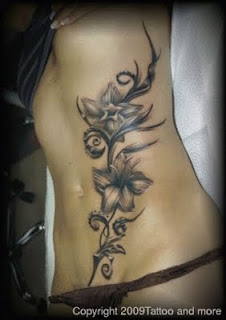Tattoo Designs Today
So much choice
Fast forward to today: men and women, young and old alike are drawn to tattoos. There is little if any social stigma left. Even people you might never expect to have tattoos – like middle aged or older women – have them and love them. And in terms of tattoo designs, again, there are no limits. We draw on world history, cross cultural designs, and modern art. A Maori symbol might make a cool tattoo design, but so might something from the Celtic or Native American culture. With all that choice, how do you go about choosing tattoo designs?
Start with everyone’s favorite information source – the internet. Look for free tattoo designs online and you’ll find a wealth of images. It may take some searching, but eventually you will come up with so many designs that the problem becomes narrowing it down to those you find attractive and are able to use. Here are some things to keep in mind: often, simple tattoo designs are the best because they allow for the boldest lines. Colors are great, but they do tend to fade a bit faster than black, so that’s another thing to keep in mind. If you haven’t gotten a tattoo before and you don’t have an image in mind, look for small tattoo designs. Some of them can be added to later on, but a smaller image is a great place to start.
Finally, enjoy yourself. The fact that there are so many tattoo designs available to day is reminiscent of a lot other things in our culture. For example, if you live in a larger town or city, chances are that you have food from many different world cuisines easily available to you. All the options can make choosing harder, but the payoff is great. The main thing about choosing tattoo designs is to choose one that appeals to you, personally – you’re the one who’s going to be living with it!
Tuesday, December 2, 2008
How To Take Great Tattoo Pictures
 If you are looking for tattoo pictures, you go here: Tattoo Gallery or Tattoo Battles or Chopper Tattoo.
If you are looking for tattoo pictures, you go here: Tattoo Gallery or Tattoo Battles or Chopper Tattoo.Taking a good picture of your tattoo is no rocket sience, but you need to follow some guidelines to get good looking tattoo pictures. Here are a few hints and tips that will help you taking quality pics of your ink...
1. Most tattoo pictures you see online are taken right after the tattoo has been finished. I understand, you just had new ink and you want to show it to the world, but the fact is that a new tattoo doesn't look good because of the blood, swelling and ointment covering the tattoo. Wait a couple of weeks to take a pic, until your tattoo has fully healed, then you'll be able to take that cool picture of your tattoo.
2. You need someone to help you, taking good photographs of your own body is very hard and will never produce good results.
3. Use a camera, not a webcam. It's imposible to take a good tattoo picture with a webcam.
4. The flash is not your friend because you will see reflections of it on your picture. Go outside to take tattoo pictures. If you do need to use a flash (because you can't go out because it's raining for example), apply a little cosmetic powder to the tattoo, it will reduce the glare.
5. Take a good distance: too far and you won't see the details of your design, too close and the picture will be blurred (unless you have a very good camera).
6. No shaking! Don't move while taking your tattoo picture, the results will be blurry. Try to steady your arm by placing it on top of something like a table.
7. Be creative! Try different angles, different distances, ... The beauty of a digital camera is that you can make pictures as many as you want.
If you follow these simple guidelines, you will be able to produce quality tattoo pictures. Remember to post them online here: Tattoo Battles
Monday, December 1, 2008
Feminine Tribal Tattoos Design
 Generally speaking, tribal tattoos have a masculine energy about them, given their bold, thick lines. At the same time, they are versatile and they tend to look very good on women as well. Maybe it’s the appeal of the contrast.
Generally speaking, tribal tattoos have a masculine energy about them, given their bold, thick lines. At the same time, they are versatile and they tend to look very good on women as well. Maybe it’s the appeal of the contrast.Over the past few years though, some tribal tattoo designs have evolved that are characteristically feminine in nature. They have the same recognizable tribal patterns, but they tend to be smaller and more self contained. A good example might be the tribal butterfly tattoo, a popular choice for an ankle or shoulder tattoo. A larger version of the tribal butterfly can also look good on the lower back. Tribal rose tattoos are also popular in many of the same locations.
Traditional Tribal Tattoo Art design
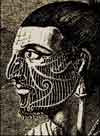 Here's an overview of tribes where tattoos played and play an important role in society:
Here's an overview of tribes where tattoos played and play an important role in society:Borneo Tattoos
Tattooing in Borneo (one of islands of Indonesia/Malaysia) is an important form of body modification. The tattoos are believed to protect against pain and diseases. The Iban, Kayan en Kenyah tribes, all headhunters, share the same style of tattoos. The Kayan used carved wood blocks or carved skulls to transfer the designs onto the skin.
Polynesian Tattoos
Polynesian tribal tattoo
Polynesia is a group of over 1000 islands in the Pacific Ocean. The most famous Polynesian tattoo styles are the Maori, Marquesan, Tahitian, Samoan and Hawaiian styles.
Read more about Polynesian Tattoos
Maori Tattoos
The Maori are the indigenous people of New Zealand. They use a form of personal identification called Ta Moko. Tattoos are used to carve the family history into the skin.
Learn more about Ta Moko and Maori Tattoos
Marquesan Tattoos
The Marquesa islands are a group of islands situated in French Polynesia. The Marquesan tattoo art greatly influenced today's tattoo artists. The hands are an important tattoo spot in the Marquesan tattoo tradition, as well as the ears, the shoulders and the lips.
Hawaiian Tribal Tattoos
Like the other tribal tattoos, tattoos in Hawaii have a hidden meaning and are believed to have magical power. They are applied during a ritual ceremony. Both men and women are tattooed with motifs like triangles, squares, crescents and animals like sharks and lizards.
More about Hawaiian Tattoos
Taino Tattoos
The Taino were Indians that lived in the area of the Caribbean Sea: the Dominican, Haiti, Cuba, Jamaica, Puerto Rico, the Bahamas, ... They were the first people Christoffel Columbus came in contact with in 1492.
Tattoos were an expression of faith for the Taino people, the higher the tattoos were on their body, the closer they were to god. Tattoos were usually worn by men, the women wore piercings.
Celtic Tattoos

The Celtic people used to live in tribes spread over Great Britain and parts of Western Europe and were heavily tattooed. Interlacing patterns, spirals and knot work are typical for Celtic tattoos.
More about Celtic Tattoos
Tattoos played a big role in the culture of the American Indians. They were used for identification, to give praise and to give magical powers or protection. Typical Native American tattoo designs include animals (eagles, snakes, bears), feathers and mythical creatures.
Aztec Tribal Tattoos
The Aztecs were another group of Native Americans. They lived in central America from the 13th to the 16th century and used tattoos to mark a warrior's rank and differentiate between the various tribes. Typical Aztec tattoos include gods like Quetzalcoatl and Huitilopochtili, suns and eagles.
Learn more about Aztec Tattoos
The history of the Chinese tattoo is not very interesting, but there are several ethnic minorities in China with a strong tattoo tradition. The most important tribes are those of the Dai, Drung and Li.
More about the Chinese Tattoo

Haida Tattoos
The Haidas are the indigenous people of the territory that lies on the west coast of North America (southeast Alaska). The people of the haida tribe decorate their objects with crests (totems) and use tattoos to represent the family crest and social status. The crests included all kinds of animals (killer whale, shark, wolf, eagle, owl) as well as the sun, the moon, clay, ...
Tribal Tattoos designs
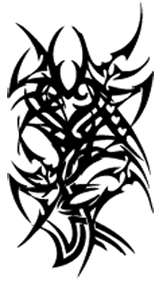 Tribal tattoos have been in vogue for quite a while now (since the early 1990s) and it’s easy to see why, they just look good.
Tribal tattoos have been in vogue for quite a while now (since the early 1990s) and it’s easy to see why, they just look good.Advantages of getting a tribal tattoo:
The tattoos of an older Indian woman
* There's a lot of black ink in tribal tattoos, which has the advantage that it holds up very well, black tattoo ink doesn't fade as fast as other colors.
* Tribal tattoo designs are very popular, so as long as you don't want a specific or traditional tribal, you shouldn't have a hard time finding a good tattoo artist that can design your custom tattoo.
* It's easier to design your own tattoo or at least a mockup of your own tribal than it is with other tattoo designs.
* Tribal tattoos have a bold visual appeal: their thick, black curving lines and interlocking patterns lend themselves well to many of the standard tattoo locations, such as the upper arm (in the form of a tribal armband for example) , the back or the lower back.
Disadvantages of tribal tattoos:
* Tattoo removal is not working very good on those large patches of black ink.
* Covering them up with another tattoo ain't working either.
* Finding a tattoo artist or tattoo parlor is not easy when you want a traditional design of a specific tribe.
* When you're getting a tattoo that is an imitation of a traditional tribal design, keep in mind that you might be insulting the original tribe members. This is especially the case with Ta Moko, which is a form of family and personal identification of the Maori people. Copying their designs is a form a identity theft.
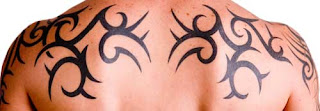
Tribal tattoo design
The tribal styles we see today originate from various old tribes like those from Borneo, the Haida, the Native Americans, the Celtic tribes, the Maori and other Polynesian tribes.
The shapes and motifs of these tribal tattoos are deeply rooted in the tribe's mythology and view of the world. The traditional tattoo artist aims to reflect the social and religious values of the tribe in his tattoo designs. Recurring themes are the rituals of the tribe, the ancestors, the origins of the world and the relationship with the gods.
What are tattoos used for in tribal communities?
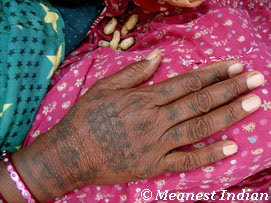
* Identification: each tribe and family has its own tattoo motifs. Tribal tattoos read like a book: they tell a lot about the origin and the social hierarchy of the person who wears them. Tribe members can identify each other by their tattoos, in this life and in the afterlife.
* Social status: the style and size of a tribal tattoo says a lot about a person's social status in the group. A person with a big tattoo usually has a higher rank in the society compared to one with a simple tattoo.
* Rite of passage: getting a tattoo is part of the ritual that turns a boy into a man, a girl into a woman.
* Magic, healing and protection: tribal tattoos are believed to have magical powers. In some tribes the boy gets assigned a totem animal during his rights of passage. By tattooing that animal it is believed that the wearer inherits some of the powers of his totem animal.
Tribal tattoos
Modern tribal tattoos are generally speaking not strongly associated with any particular tribe and are usually stripped of their social meaning. Tribal tattoo art we see in the Western world today are often based on:
* Polynesian tattoo designs
* The tattoo designs of the tribes of Borneo, namely the Iban and Kayan (Sarawak) and the Kenyah (Kalimantan)
Tattoo artists like Leo Zulueta, an American with Filipino roots, and Alex Binnie, from London, had a great influence on the development of this modern tribal tattoo style.
Traditional application of a tribal tattoo
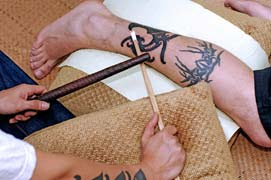
Luckily for today's tribal tattoo lovers, the methods used to apply the tattoos have changed. Bone needles and plant or animal dyes have been replaced by tattoo machines and the circumstances in which a tattoo artist today works are generally more hygienic than those of a tribal community. Some people though, want to go all the way and prefer to be tattooed using the traditional methods.
Saturday, November 1, 2008
the best LA ink | TATTOOS GIRLS
(Silver Spring, MD) For centuries the tattoo industry has been dominated by men. In TLC�s new series LA INK (premiered Tuesday, August 7th at 10 PM ET/PT), the glass ceiling is shattered as three of the most respected female tattoo artists, along with one legendary male artist, come together to work at the newest and hottest tattoo shop in LA. Joining shop owner Kat Von D at LA INK are renowned tattoo artists Kim Saigh, Hannah Aitchison and Kat�s mentor, Corey Miller. The shop manager holding everything together is Kat�s good friend, Pixie. With the majority of the artists in the shop being woman, LA INK shows that great art shares no gender bias.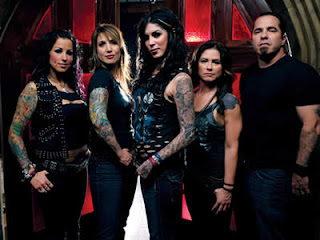 The shop, which Kat recently opened in Hollywood, will have a distinct rock-n-roll flavor reflecting the owner�s personal style. Filled with gorgeous black and white photography and memorabilia signed by legendary rock artists and professional athletes, LA INK has a glam-rock feel that is inviting to celebrities, athletes, rockers and regular people alike. Following the lead set by their boss, Kat Von D, these tattoo artists (and shop manager) play by their own rules and live a fast-paced, rebel lifestyle. They set their own schedule, pick their clients, sleep late and party all night long. Together, the cast of LA INK will share their lives showing the culture and stories behind tattoos.
The shop, which Kat recently opened in Hollywood, will have a distinct rock-n-roll flavor reflecting the owner�s personal style. Filled with gorgeous black and white photography and memorabilia signed by legendary rock artists and professional athletes, LA INK has a glam-rock feel that is inviting to celebrities, athletes, rockers and regular people alike. Following the lead set by their boss, Kat Von D, these tattoo artists (and shop manager) play by their own rules and live a fast-paced, rebel lifestyle. They set their own schedule, pick their clients, sleep late and party all night long. Together, the cast of LA INK will share their lives showing the culture and stories behind tattoos.
Through TLC�s hit series MIAMI INK, artist Kat Von D tattooed her way onto the world�s stage, becoming one of the most talked about and sought after tattoo artists on the planet. Throughout her 11-year career, Kat has worked alongside men, not only surviving, but thriving. Now, after leaving Miami for her home-town of LA, she is realizing a dream by opening up her first business.
tattoos girls Kat Von D was one of the featured artists on the first two seasons of MIAMI INK, which has traveled the globe, airing in many countries including Japan, Australia, Brazil and England. TLC�s season two finale, which aired on May 8th was watched by over 3,000,000 people*. Kat specializes in fine-line, black & gray style life-like portraits. In more than a decade of being a professional tattoo artist she has amassed a devout following including over 1,372,000 friends on her myspace.com page and thousands more checking her out at TLC.com/LA-Ink. In addition, many celebrities, athletes and entertainers seek out her services such as Jackass� Bam Margera; Steve-O and Ryan Dunn; Slayer; My Chemical Romance; Guns N Roses; Green Day; The Mars Volta; Eve and Mira Sorvino.
Kat Von D was one of the featured artists on the first two seasons of MIAMI INK, which has traveled the globe, airing in many countries including Japan, Australia, Brazil and England. TLC�s season two finale, which aired on May 8th was watched by over 3,000,000 people*. Kat specializes in fine-line, black & gray style life-like portraits. In more than a decade of being a professional tattoo artist she has amassed a devout following including over 1,372,000 friends on her myspace.com page and thousands more checking her out at TLC.com/LA-Ink. In addition, many celebrities, athletes and entertainers seek out her services such as Jackass� Bam Margera; Steve-O and Ryan Dunn; Slayer; My Chemical Romance; Guns N Roses; Green Day; The Mars Volta; Eve and Mira Sorvino.
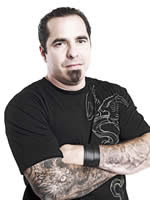 Joining Kat at her new shop is Corey Miller, a legend in the industry. Tattooing for over 25 years, this California native has inked people all around the world from Japan and Amsterdam to Hawaii and Paris. He specializes in black & gray portraits and dragons that merge the traditional and classic styles with his own. A true master, Corey is known for his freehand work, drawing the image directly onto the skin, foregoing any stencil. He has an extensive client list, including celebrities like James Hettfield from Metallica, Jason Giambi of the NY Yankees and Jesse James. In his spare time, this married father of three enjoys playing the drums.
Joining Kat at her new shop is Corey Miller, a legend in the industry. Tattooing for over 25 years, this California native has inked people all around the world from Japan and Amsterdam to Hawaii and Paris. He specializes in black & gray portraits and dragons that merge the traditional and classic styles with his own. A true master, Corey is known for his freehand work, drawing the image directly onto the skin, foregoing any stencil. He has an extensive client list, including celebrities like James Hettfield from Metallica, Jason Giambi of the NY Yankees and Jesse James. In his spare time, this married father of three enjoys playing the drums.
 A fanatical yoga practitioner, tattoo artist Kim Saigh takes a lot of the teachings of the discipline and puts it into her art. Allegorical and illustrative works that express movement and flow dominate Kim�s portfolio. Tattooing professionally for 16 years, Kim first got her start in her native Cleveland, moving to Chicago and opening her first shop a few years later. Kim now splits her time between LA and Chicago but always has her black Persian cat, Geezer with her.
A fanatical yoga practitioner, tattoo artist Kim Saigh takes a lot of the teachings of the discipline and puts it into her art. Allegorical and illustrative works that express movement and flow dominate Kim�s portfolio. Tattooing professionally for 16 years, Kim first got her start in her native Cleveland, moving to Chicago and opening her first shop a few years later. Kim now splits her time between LA and Chicago but always has her black Persian cat, Geezer with her.
 Hannah AitchisonHannah Aitchison has been tattooing for over a decade. Specializing in bold, colorful, illustrative works including life-like portraits, pin-ups and classic Americana, Hannah enjoys a technical challenge in the tattoos she creates. A single mom, Hannah worked two and three jobs while apprenticing just to support her daughter. When not tattooing or spending time with her daughter, Hannah enjoys painting, knitting, boxing and traveling.
Hannah AitchisonHannah Aitchison has been tattooing for over a decade. Specializing in bold, colorful, illustrative works including life-like portraits, pin-ups and classic Americana, Hannah enjoys a technical challenge in the tattoos she creates. A single mom, Hannah worked two and three jobs while apprenticing just to support her daughter. When not tattooing or spending time with her daughter, Hannah enjoys painting, knitting, boxing and traveling.
 LA INK shop manager, Pixie loves to surround herself with bright, colorful, �yummy� things. Judging by the elaborate, colorful tattoos of cupcakes, Care Bears and other assorted �happy� visions, and intense body modifications that adorn her body, Pixie has a zest for life. The former Fear Factor game show winner is a Pescatarian (vegetarian who eats fish), loves animals and lives in Los Angeles with her two pitbulls, Cup Cake and Chopper, and her cat, Monkey. Before moving to LA four years ago, Pixie was a body piercer at atattoo shop in Minnesota. These days, when not working at the shop she is a freelance make up artist.
LA INK shop manager, Pixie loves to surround herself with bright, colorful, �yummy� things. Judging by the elaborate, colorful tattoos of cupcakes, Care Bears and other assorted �happy� visions, and intense body modifications that adorn her body, Pixie has a zest for life. The former Fear Factor game show winner is a Pescatarian (vegetarian who eats fish), loves animals and lives in Los Angeles with her two pitbulls, Cup Cake and Chopper, and her cat, Monkey. Before moving to LA four years ago, Pixie was a body piercer at atattoo shop in Minnesota. These days, when not working at the shop she is a freelance make up artist.
LA INK is produced by Original Media for TLC. Pamela Deutsch is the executive producer for TLC. Charlie Corwin is the executive producer for Original Media.
TLC is a property of Discovery Communications, the number-one nonfiction media company reaching more than 1.5 billion cumulative subscribers in over 170 countries. Through TV and digital media, Discovery's 100-plus worldwide networks include Discovery Channel, TLC, Animal Planet, The Science Channel, Discovery Health and Discovery HD Theater. Discovery Communications is owned by Discovery Holding Co. (NASDAQ: DISCA, DISCB), Advance/Newhouse Communications and John S. Hendricks, Discovery's founder and chairman. For more information please visit www.discovery.com.
 The shop, which Kat recently opened in Hollywood, will have a distinct rock-n-roll flavor reflecting the owner�s personal style. Filled with gorgeous black and white photography and memorabilia signed by legendary rock artists and professional athletes, LA INK has a glam-rock feel that is inviting to celebrities, athletes, rockers and regular people alike. Following the lead set by their boss, Kat Von D, these tattoo artists (and shop manager) play by their own rules and live a fast-paced, rebel lifestyle. They set their own schedule, pick their clients, sleep late and party all night long. Together, the cast of LA INK will share their lives showing the culture and stories behind tattoos.
The shop, which Kat recently opened in Hollywood, will have a distinct rock-n-roll flavor reflecting the owner�s personal style. Filled with gorgeous black and white photography and memorabilia signed by legendary rock artists and professional athletes, LA INK has a glam-rock feel that is inviting to celebrities, athletes, rockers and regular people alike. Following the lead set by their boss, Kat Von D, these tattoo artists (and shop manager) play by their own rules and live a fast-paced, rebel lifestyle. They set their own schedule, pick their clients, sleep late and party all night long. Together, the cast of LA INK will share their lives showing the culture and stories behind tattoos.Through TLC�s hit series MIAMI INK, artist Kat Von D tattooed her way onto the world�s stage, becoming one of the most talked about and sought after tattoo artists on the planet. Throughout her 11-year career, Kat has worked alongside men, not only surviving, but thriving. Now, after leaving Miami for her home-town of LA, she is realizing a dream by opening up her first business.
tattoos girls
 Kat Von D was one of the featured artists on the first two seasons of MIAMI INK, which has traveled the globe, airing in many countries including Japan, Australia, Brazil and England. TLC�s season two finale, which aired on May 8th was watched by over 3,000,000 people*. Kat specializes in fine-line, black & gray style life-like portraits. In more than a decade of being a professional tattoo artist she has amassed a devout following including over 1,372,000 friends on her myspace.com page and thousands more checking her out at TLC.com/LA-Ink. In addition, many celebrities, athletes and entertainers seek out her services such as Jackass� Bam Margera; Steve-O and Ryan Dunn; Slayer; My Chemical Romance; Guns N Roses; Green Day; The Mars Volta; Eve and Mira Sorvino.
Kat Von D was one of the featured artists on the first two seasons of MIAMI INK, which has traveled the globe, airing in many countries including Japan, Australia, Brazil and England. TLC�s season two finale, which aired on May 8th was watched by over 3,000,000 people*. Kat specializes in fine-line, black & gray style life-like portraits. In more than a decade of being a professional tattoo artist she has amassed a devout following including over 1,372,000 friends on her myspace.com page and thousands more checking her out at TLC.com/LA-Ink. In addition, many celebrities, athletes and entertainers seek out her services such as Jackass� Bam Margera; Steve-O and Ryan Dunn; Slayer; My Chemical Romance; Guns N Roses; Green Day; The Mars Volta; Eve and Mira Sorvino. Joining Kat at her new shop is Corey Miller, a legend in the industry. Tattooing for over 25 years, this California native has inked people all around the world from Japan and Amsterdam to Hawaii and Paris. He specializes in black & gray portraits and dragons that merge the traditional and classic styles with his own. A true master, Corey is known for his freehand work, drawing the image directly onto the skin, foregoing any stencil. He has an extensive client list, including celebrities like James Hettfield from Metallica, Jason Giambi of the NY Yankees and Jesse James. In his spare time, this married father of three enjoys playing the drums.
Joining Kat at her new shop is Corey Miller, a legend in the industry. Tattooing for over 25 years, this California native has inked people all around the world from Japan and Amsterdam to Hawaii and Paris. He specializes in black & gray portraits and dragons that merge the traditional and classic styles with his own. A true master, Corey is known for his freehand work, drawing the image directly onto the skin, foregoing any stencil. He has an extensive client list, including celebrities like James Hettfield from Metallica, Jason Giambi of the NY Yankees and Jesse James. In his spare time, this married father of three enjoys playing the drums. A fanatical yoga practitioner, tattoo artist Kim Saigh takes a lot of the teachings of the discipline and puts it into her art. Allegorical and illustrative works that express movement and flow dominate Kim�s portfolio. Tattooing professionally for 16 years, Kim first got her start in her native Cleveland, moving to Chicago and opening her first shop a few years later. Kim now splits her time between LA and Chicago but always has her black Persian cat, Geezer with her.
A fanatical yoga practitioner, tattoo artist Kim Saigh takes a lot of the teachings of the discipline and puts it into her art. Allegorical and illustrative works that express movement and flow dominate Kim�s portfolio. Tattooing professionally for 16 years, Kim first got her start in her native Cleveland, moving to Chicago and opening her first shop a few years later. Kim now splits her time between LA and Chicago but always has her black Persian cat, Geezer with her. Hannah AitchisonHannah Aitchison has been tattooing for over a decade. Specializing in bold, colorful, illustrative works including life-like portraits, pin-ups and classic Americana, Hannah enjoys a technical challenge in the tattoos she creates. A single mom, Hannah worked two and three jobs while apprenticing just to support her daughter. When not tattooing or spending time with her daughter, Hannah enjoys painting, knitting, boxing and traveling.
Hannah AitchisonHannah Aitchison has been tattooing for over a decade. Specializing in bold, colorful, illustrative works including life-like portraits, pin-ups and classic Americana, Hannah enjoys a technical challenge in the tattoos she creates. A single mom, Hannah worked two and three jobs while apprenticing just to support her daughter. When not tattooing or spending time with her daughter, Hannah enjoys painting, knitting, boxing and traveling. LA INK shop manager, Pixie loves to surround herself with bright, colorful, �yummy� things. Judging by the elaborate, colorful tattoos of cupcakes, Care Bears and other assorted �happy� visions, and intense body modifications that adorn her body, Pixie has a zest for life. The former Fear Factor game show winner is a Pescatarian (vegetarian who eats fish), loves animals and lives in Los Angeles with her two pitbulls, Cup Cake and Chopper, and her cat, Monkey. Before moving to LA four years ago, Pixie was a body piercer at atattoo shop in Minnesota. These days, when not working at the shop she is a freelance make up artist.
LA INK shop manager, Pixie loves to surround herself with bright, colorful, �yummy� things. Judging by the elaborate, colorful tattoos of cupcakes, Care Bears and other assorted �happy� visions, and intense body modifications that adorn her body, Pixie has a zest for life. The former Fear Factor game show winner is a Pescatarian (vegetarian who eats fish), loves animals and lives in Los Angeles with her two pitbulls, Cup Cake and Chopper, and her cat, Monkey. Before moving to LA four years ago, Pixie was a body piercer at atattoo shop in Minnesota. These days, when not working at the shop she is a freelance make up artist.LA INK is produced by Original Media for TLC. Pamela Deutsch is the executive producer for TLC. Charlie Corwin is the executive producer for Original Media.
TLC is a property of Discovery Communications, the number-one nonfiction media company reaching more than 1.5 billion cumulative subscribers in over 170 countries. Through TV and digital media, Discovery's 100-plus worldwide networks include Discovery Channel, TLC, Animal Planet, The Science Channel, Discovery Health and Discovery HD Theater. Discovery Communications is owned by Discovery Holding Co. (NASDAQ: DISCA, DISCB), Advance/Newhouse Communications and John S. Hendricks, Discovery's founder and chairman. For more information please visit www.discovery.com.
Subscribe to:
Comments (Atom)


